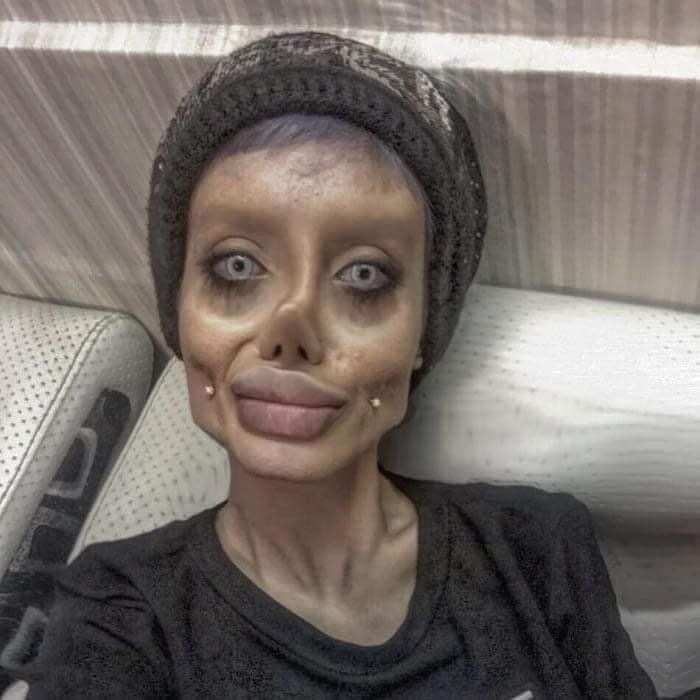
At just 19 years old, Sahar reportedly underwent more than 50 cosmetic procedures, including liposuction, nose reshaping, and lip augmentation. Her haunting look featured dramatically hollowed cheekbones, exaggerated lips, and a nose so sharp it seemed almost cartoonish. While Sahar herself never explicitly claimed she was trying to look like Angelina Jolie, her followers made the connection, dubbing her the “Zombie Angelina Jolie.” She leaned into the comparison, frequently sharing photos of her appearance on Instagram, where her account, @sahartabar_official, once boasted nearly four million followers.
However, not everything was as it seemed. Many experts and observers suggested that Sahar’s shocking appearance was not entirely the result of surgeries. Instead, it appeared that heavy photo editing and digital manipulation played a significant role in creating her viral look. In interviews, Sahar later confirmed this, admitting that her photos were enhanced with filters and editing tools. “Every time I publish a photo, I paint my face in an increasingly funny way. It’s a way of expressing myself—a kind of art,” she shared in an interview with Russian media outlet Sputnik.
Sahar insisted she never intended to look like Angelina Jolie or even Tim Burton’s animated character, The Corpse Bride. “I didn’t even think about resembling Jolie,” she explained. “I understand now that people make the comparison, but my goal was never to imitate anyone. I see myself as my own muse.” Her online presence was, in her eyes, a form of self-expression and a shortcut to fame. “Cyberspace was an easy way to become known. Much easier than becoming an actor,” she admitted.
But her viral fame came with severe consequences. In October 2019, Sahar was arrested by Iranian authorities. Her charges included blasphemy, inciting violence, influencing the youth negatively, illegally obtaining property, and violating Iran’s strict dress codes for women. These accusations painted a much darker picture of her online activities than her social media posts suggested. Despite her claims that her online persona was nothing more than a performance, Sahar was handed a harsh sentence: 10 years in prison. Even more alarming, she was sent to Qarchak Prison—widely regarded as one of the harshest facilities for women in Iran, notorious for its appalling living conditions and inhumane treatment of inmates.
During her imprisonment, Sahar’s mother reportedly endured unimaginable anguish. She pleaded for her daughter’s release, her cries echoing through activist circles and social media campaigns. One prominent activist, Masih Alinejad, took to Twitter to amplify Sahar’s story. “Sahar Tabar is only 19. Her joke landed her in jail. Her mother cries every day to get her innocent daughter freed. Dear Angelina Jolie, we need your voice here. Help us.” The call to action was a plea for international attention, hoping that the real Angelina Jolie—a renowned humanitarian—might intervene or bring awareness to Sahar’s plight.
After serving 14 months of her 10-year sentence, Sahar was finally released from prison. Reports suggest her release was partially influenced by the public outcry surrounding the tragic death of Mahsa Amini. Amini, a young Iranian woman, died in police custody after being arrested and beaten for allegedly wearing her hijab incorrectly. This event triggered massive protests across Iran and drew international condemnation. Amid the escalating pressure on Iranian authorities, Sahar was granted her freedom.
Reflecting on her time in prison, Sahar reportedly expressed regret over the path her life had taken. What began as an attempt to gain fame and express herself artistically had spiraled into a nightmare she never anticipated. Her story serves as a powerful reminder of the unpredictable consequences of social media stardom, particularly in countries with strict laws governing online behavior and personal expression.
Today, Sahar Tabar remains a controversial figure. Her story is both a cautionary tale and a reflection of a society grappling with the influence of social media, the pursuit of fame, and the intersection of personal freedom with cultural and legal restrictions. While her Instagram account has been deleted, and she has largely stepped away from the spotlight, her story continues to spark debates about online behavior, societal judgment, and the consequences of seeking validation in the digital world.
For many, Sahar represents the darker side of internet fame—a world where fleeting recognition can come with life-altering consequences. Whether she chooses to return to social media or live a quieter life away from the public eye, her experience serves as a lesson in the power and pitfalls of online influence. It’s a reminder that what we see on our screens is often only a curated illusion, and the price of that illusion can sometimes be unimaginably high.



